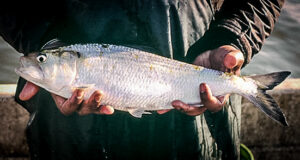Fish in the Potomac River
Interstate Commission on the Potomac River Basin
 Fish are perhaps the most well-known and charismatic members of aquatic communities and have vital ecological roles. Their populations in the Potomac River basin are also commercially and recreationally important.
Fish are perhaps the most well-known and charismatic members of aquatic communities and have vital ecological roles. Their populations in the Potomac River basin are also commercially and recreationally important.
- Fish in Tidal Fresh Potomac Estuary and Anacostia: Alewife, Blueback herring, and American Shad population surveys and development of analytical tools. Potomac populations of Atlantic sturgeon and other migratory species.
- Trout Movements in the North Branch Potomac River: Movements of brook trout to find cold water habitats and survive summer heat are tracked by ICPRB with acoustic transmitters. (ICPRB 93-1 NBPR fish)
- The Little Falls Fishway and American Shad Restoration: ICPRB spearheaded a collaborative effort to stock American shad that began in 1995. The effort was designed to imprint shad to the historic Potomac spawning and nursery waters and help stocks reestablish while the fishway was being built.
Resources
Fisheries Management in the Potomac basin
- Potomac River Fisheries Commission
- Maryland Department of Natural Resources/Fisheries
- Virginia Department of Wildlife Resources/Fishing
- District of Columbia Department of Energy and Environment/Fisheries Management
- West Virginia Department of Natural Resources/Fishing
- Pennsylvania Fish and Boat Commission/Fish
Recruitment Surveys in the Potomac basin
- Maryland Upper Potomac Smallmouth Bass Survey
- Maryland Striped Bass Spring Spawning Stock Assessment
- Maryland Juvenile Striped Bass Seine Survey
- Virginia Juvenile Striped Bass Seine Survey
- Virginia Juvenile Fish and Blue Crab Trawl Survey
Trout Movements in the North Branch Potomac River
In 2019, the ICPRB and the United States Army Corps of Engineers (USACE) conducted a review of Jennings Randolph Lake’s operational guidelines and their impacts on conditions in the North Branch Potomac River downstream of the dam (Schultz et al 2020, Buchanan and Selckmann 2019). Since the dam was built in 1982, lake operations have successfully reduced the downstream risk of flooding and provided drinking water for the metropolitan Washington D.C. area during droughts. Restoration efforts in the watershed outside of the influence of USACE operations (e.g., acid mine remediation, wastewater treatment, reforestation) significantly improved the river’s water quality, which led to significantly improved source water, a return of stream life, and a burgeoning recreation industry. In response, USACE included additional biological and recreational objectives to their 1997 operations manual.
The ICPRB and USACE review concluded operational impacts are difficult to assess without further water quality monitoring and biological sampling. For example, there are no data documenting a) the role of low flow augmentation in diluting municipal and industrial waste and preventing formation of low dissolved oxygen zones, b) the efficacy of artificially varied flows to flush built-up organic sediments, or c) the extent of biological benefits from cool/cold-water releases in summer. The North Branch system is now economically significant as a trout fishery and a boating and whitewater recreation location, and population growth in the river basin is increasing the lake’s importance as a water supply source during drought. Informed management decisions that best address all stakeholder needs and priorities is paramount, second only to the lake’s primary authorized purpose of flood risk management.
In 2022, the ICPRB, with Maryland DNRs help, will conduct a study to collect key monitoring datasets that support flow and temperature model development and better characterize the extent and duration of optimal habitat conditions for cold-water fish. These data will eventually facilitate better operational decision-making for the multiple stakeholders in the North Branch Potomac River.
As part of this study, ICPRB will take the following actions:
- Collect high frequency temperature and dissolved oxygen data to inform instream model developments;
- Conduct a trout telemetry study to delineate movement behavior as well as the temporal and spatial range of economically and biologically important trout species, and;
- Explore modeling alternatives to explore and optimize the needs of a multi-stakeholder resource.
Return to Aquatic Life Main Page

